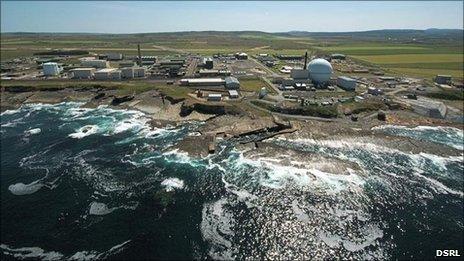Dounreay reports on tsunami and earthquake resilience
- Published

Tsunami threats to Dounreay were investigated in 1996 and 2003
The company leading the demolition of a Scottish nuclear plant has reported on the site's ability to withstand an earthquake or tsunami.
Dounreay lies on the Caithness coast at least 10m (32ft) above sea level.
The report on Dounreay's "seismic and tsunami resilience" has been sent to the Nuclear Installations Inspectorate.
All UK nuclear sites were asked for a report following the massive earthquake and a tsunami that hit Japan on 11 March.
The massive quake knocked out cooling systems to reactors at the country's Fukushima nuclear plant.
Very low levels of radioactive iodine believed to be linked to the crippled plant have since been detected at Dounreay.
Dounreay Site Restoration Limited's (DSRL) report draws on work commissioned in 1996 and 2003 that considered the threats posed by a tidal wave, either caused by an earthquake or an underwater rock slide.
The company said the reports concluded that Dounreay was in "a very seismically stable area" and, due to this stability, a tsunami was unlikely to occur from an earthquake.
The reports' researchers looked at a tsunami which happened 7,000 years ago, caused by a rock slide near Norway. It resulted in a wave 4m (13ft) high.
Researchers concluded a similar event would have a minimal effect on Dounreay.
DSRL said: "Due to the decommissioning, none of the reactors or waste storage facilities on the site require any cooling, unlike at Fukushima.
"A nitrogen 'blanket' is maintained at the Dounreay Fast Reactor to cover the liquid metal remaining in the reactor to prevent it reacting with air, and the back-up supplies would last for several days.
"We will implement whatever recommendations the NII make in response to our report."
Landmark dome
Dealing with the impact of coastal erosion at the site has been another ongoing matter for DSRL.
The company is leading the £2.6bn demolition and clean up of the experimental nuclear power complex where the first buildings were constructed in the 1950s.
Most of the structures, including the landmark dome, should be cleared during the next 20 years.
However, DSRL has forecast that nuclear waste could be stored at the site until 2057 and the land not made available for reuse until the year 2294.
Bird droppings
The work at Dounreay has included the clean up of ventilation systems in line with a request from the Scottish Environment Protection Agency (Sepa).
Debris had built up in the systems that draw air into areas where radioactive material is held.
DSRL said this increased the risk of poor operation and chances of radioactive particles escaping.
The clean up saw the removal of 3.5 tonnes of bird droppings from the base of a ventilation stack at Dounreay's Prototype Fast Reactor.
- Published26 April 2011
- Published21 April 2011
- Published1 April 2011
- Published24 March 2011
- Published23 March 2011
- Published4 March 2011
- Published2 March 2011